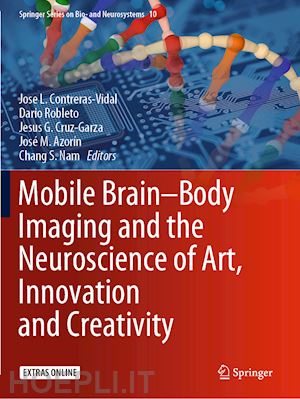
Questo prodotto usufruisce delle SPEDIZIONI GRATIS
selezionando l'opzione Corriere Veloce in fase di ordine.
Pagabile anche con Carta della cultura giovani e del merito, 18App Bonus Cultura e Carta del Docente
This book addresses a set of universal and timeless questions with a profound impact on the human condition:
Mobile Brain–Body Imaging and the Neuroscience of Art, Innovation and Creativity is written for academic researchers, professionals working in industrial and clinical centers, independent researchers and artists from the performing arts, and other readers interested in understanding emergent innovations at the nexus of art, science, engineering, medicine and the humanities. The book contains language, design features (illustrations, diagrams) to develop a conversational bridge between the disciplines involved supplemented by access to video, artistic presentations and the results of a hackathon from the MoBI conferences.
Foreword .- Introduction.- Part I.- Neuroaesthetics and Creativity: How Do the Creative Arts Engage the Human Mind and Promote Creativity and Innovation Across Fields?.- Introduction to Part I.- How Artists Think (or the History of Neuroaesthetics).- Art and Neuroscience: a State of the Union.- Brain Mechanisms of Creativity: What We Know, What We Don’t.- SPECIAL MULTIMEDIA FEATURE: Interviews.- Part II: How Do Arts-Science Collaboration Create New Knowledge through Aesthetic Problem Solving?.- Introduction to Part II.- Myths and Realities of Art: Science Collaborations.- Forging New Paths between Art, Materials and Society.- Is Beauty in the Eye of the Beholder or an Objective Truth? A Neuroscientific Approach.- Part III: Brain Mechanisms of Aesthetic Perception and Artistic Brain–Computer Interfaces.- Introduction to Part III.- How We See Art and How Artists Make It.- Reverse Engineering of Creativity.- Chapter 9 (no title yet).- SPECIAL MULTIMEDIA FEATURE Your Brain on Art: Creativity in Sound, Movement and Visual Arts.- Part IV: Cognitive and Medical Applications: How Can Arts and Neuroscience Research Improve Physical and Mental Health and Promote Wellbeing?.- Introduction to Part IV.- Outcomes of Art Therapy Treatment for Military Service Members with Traumatic Brain Injury and Post-Traumatic Stress.- Brain on Art therapy: Examining Processes and Outcomes of Art Making in Therapeutic Contexts.- Chapter 12: No title (TBC).- Part V. Mobile Brain–Body Imaging Technologies: How Disruptive Neurotechnologies Are Changing Science, Arts and Innovation.- Introduction to Part V.- Control Mechanisms in Artistic Brain–Computer Interfaces.- The Art, Science and Engineering of BCI Hackathons.- ArtScience Navigating the Ecology of Knowledge: Lessons Learned and Suggestions for Transdisciplinary Apprenticeships.- Part VI. How Can The Arts and Neuroscience Describe and Promote the Processes of Learning and Creativity in K-12 and Higher Education?.- Introduction to Part VI.- The Effects of Arts Integration on Learning: From Research to Practice.- Bach to Explore the Tension between Novelty and Familiarity and Examine the Implications for Imaging/Brain Science.- No title (TBA).- Part VII. Experiential Learning in Art–Science Hackathons.- Introduction to Part VII.- Brain and Painting.- Do, Re, Mi and EEG.- Purpose-Specific EEG Placement Prototype to Limit User Discomfort and Burden.- Harnessing Creative Skill Training in Artistic BCIs.- True Integration, the MoBI Hackathon for STEM informing Arts and Arts informing STEM.- Paint with Brainwaves: An Active BCI Painting Prototype.- Mediated Interdependence in Motion: A Co-op Augmented Reality and Brain-Computer Interface Installation.- Mind’s EYE: Multimodal Theatrical Staging: An Alternative Picture of a Human Mind.- Part VIII: Roadmap.
Dario Robleto received his BFA from the University of Texas at San Antonio in 1997. The Houston-based artist has had numerous solo exhibitions since 1997, most recently at the Menil Collection, Houston, TX (2014); the Baltimore Museum of Art (2014); the New Orleans Museum of Art (2012); and the Museum of Contemporary Art, Denver (2011). His work has been profiled in numerous publications and media including Radiolab, Krista Tippet's On Being, and the New York Times. In 2008 a 10-year survey exhibition, Alloy of Love, was organized by the Frances Young Tang Teaching Museum and Art Gallery at Skidmore College, Saratoga Springs, New York. Accompanied by a major monograph, Alloy of Love traveled to the Frye Art Museum in Seattle, Washington.
Notable group shows include Prospect 4: The Lotus In Spite of the Swamp, New Orleans, LA (2017); Explode Every Day: An Inquiry into the Phenomena of Wonder, MASS MoCA, North Adams, MA (2016); SITE: 20 Years/20 Shows, SITE Santa Fe, NM(2015); Nouveau Festival 5th Edition, Centre Pompidou, Paris, FR (2014); The Record/Contemporary Art and Vinyl, Nasher Museum of Art, Durham, NC (2011); The Old, Weird America, Contemporary Arts Museum, Houston, TX (2008); and Whitney Biennial, Whitney Museum of American Art, New York, NY (2004).Robleto has been a visiting artist and lecturer at many universities and institutions including Bard College, Annandale-on-Hudson, NY; Massachusetts Institute of Technology, Cambridge, MA; Rhode Island School of Design, Providence, RI; and the Hubble Space Telescope Science Institute, Baltimore, MD. In 2013-14 he served as the California College of the Arts Viola Frey Distinguished Visiting Professor, Oakland, CA.
His awards have included the International Association of Art Critics Award for best exhibition in a commercial gallery at the national level (2004) and recipient of both the Joan Mitchell Foundation Grant (2007) and the USA Rasmuson Fellowship (2009). He has been a research fellow and artist in resident at institutions such as the Menil Collection (2014); the Cynthia Woods Mitchell Center for the Arts (2014); Rice University (2013-14); the Smithsonian Museum of American History (2011); the











Il sito utilizza cookie ed altri strumenti di tracciamento che raccolgono informazioni dal dispositivo dell’utente. Oltre ai cookie tecnici ed analitici aggregati, strettamente necessari per il funzionamento di questo sito web, previo consenso dell’utente possono essere installati cookie di profilazione e marketing e cookie dei social media. Cliccando su “Accetto tutti i cookie” saranno attivate tutte le categorie di cookie. Per accettare solo deterninate categorie di cookie, cliccare invece su “Impostazioni cookie”. Chiudendo il banner o continuando a navigare saranno installati solo cookie tecnici. Per maggiori dettagli, consultare la Cookie Policy.